Wildfire season goes from worse to worst Second state of emergency declared as burn area climbs to highest amount recorded
Read this article for free:
or
Already have an account? Log in here »
To continue reading, please subscribe:
Monthly Digital Subscription
$0 for the first 4 weeks*
- Enjoy unlimited reading on winnipegfreepress.com
- Read the E-Edition, our digital replica newspaper
- Access News Break, our award-winning app
- Play interactive puzzles
*No charge for 4 weeks then price increases to the regular rate of $19.00 plus GST every four weeks. Offer available to new and qualified returning subscribers only. Cancel any time.
Monthly Digital Subscription
$4.75/week*
- Enjoy unlimited reading on winnipegfreepress.com
- Read the E-Edition, our digital replica newspaper
- Access News Break, our award-winning app
- Play interactive puzzles
*Billed as $19 plus GST every four weeks. Cancel any time.
To continue reading, please subscribe:
Add Free Press access to your Brandon Sun subscription for only an additional
$1 for the first 4 weeks*
*Your next subscription payment will increase by $1.00 and you will be charged $16.99 plus GST for four weeks. After four weeks, your payment will increase to $23.99 plus GST every four weeks.
Read unlimited articles for free today:
or
Already have an account? Log in here »
Manitoba has declared a second provincewide state of emergency, as about 6,000 more evacuees fled their homes Thursday amid the worst wildfire season in at least 30 years.
The convention centre in downtown Winnipeg will become a shelter with enough space for 7,000 evacuees, following mandatory evacuations in Garden Hill Anisininew Nation — where residents were airlifted by the Canadian Armed Forces — and Snow Lake, and precautionary measures in case Thompson residents have to flee.
“The primary reason we have called this latest state of emergency is because we need access to more facilities to be able to shelter this large number of Manitobans who are being forced to flee their homes due to wildfires,” Premier Wab Kinew said at a news conference.
With hotel rooms in the capital city in short supply, the shelter at the convention centre will be set up under emergency powers. It will become active after Manitoba’s largest anime convention, Ai-Kon, is held this weekend.
“We are looking to scale up very quickly and do our best to accommodate a balancing act between those activities and the very emergent needs of wildfire evacuees and northern communities across Manitoba,” Kinew said.
The 30-day state of emergency can be extended, if necessary.
The first emergency was declared May 28, under similar circumstances. The measure was cancelled June 23, after several fires posed less of a threat and many evacuees returned home.
Manitoba’s wildfire situation recently worsened due to high temperatures, winds and lightning strikes, which have caused dozens of new fires, officials said.
More firefighters and equipment were on their way to Garden Hill, said Alex McDougall, grand chief of Anisininew Okimawin, the tribal council that represents four First Nations in the Island Lake area.
“The fire has breached and is in a portion of the community that has been evacuated,” he said by phone from Garden Hill on Thursday afternoon. “The fire has completely surrounded the community.”
High winds were expected to push flames closer, he added.
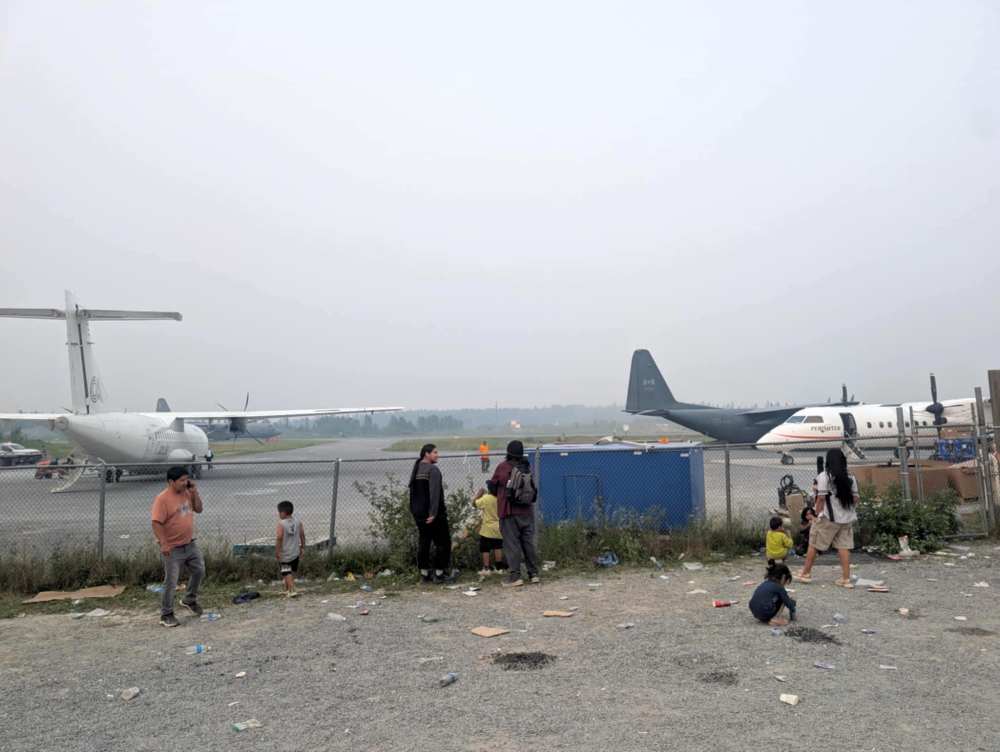
Wildfire evacuees prepare to board Canadian Armed Forces Hercules and commercial planes in Garden Hill First Nation Thursday.
McDougall said St. Theresa Point Anisininew Nation, on the opposite side of Island Lake, declared a state of emergency Thursday, while several fires burned in the region.
“That’s going to require more resources to airlift their community members,” he said of a pending evacuation.
Manitoba reported 105 active fires Thursday.
Kristin Hayward, assistant deputy minister of the Manitoba Wildfire Service, said it is the worst fire season in three decades of electronic record-keeping.
More than one million hectares of land has burned — nearly 11 times the 20-year average of 94,000 hectares — surpassing the record of 720,000 hectares in 2013, she said.
Manitoba has recorded 261 wildfires so far this year, above an average of 197 for July 10.
Mandatory evacuations were in place for nine communities or areas, displacing about 12,600 Manitobans, said Christine Stevens, assistant deputy minister of the Manitoba Emergency Management Organization.
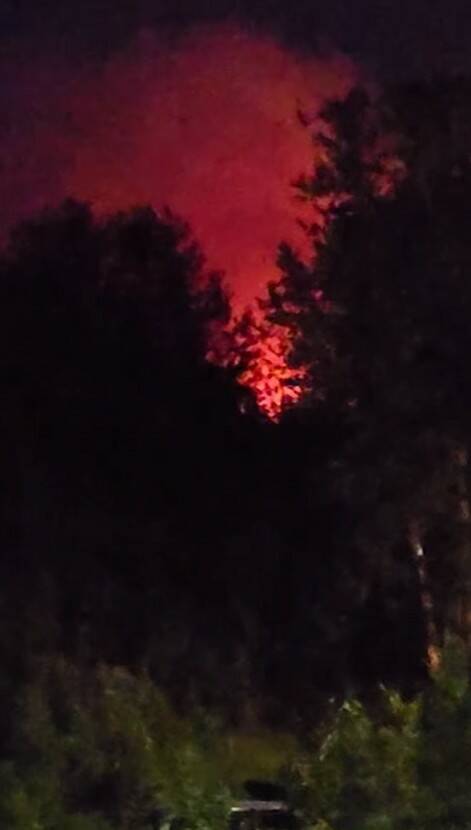
The red glow of fire can be seen through the trees near Arlene McKay’s home in Garden Hill in a video shared July 9.
There were more than 22,000 evacuees at the peak in mid-June.
More than 4,000 evacuees from Garden Hill — a remote fly-in community about 600 kilometres northeast of Winnipeg — are expected to be flown to the capital on CAF Hercules aircraft and commercial planes.
The airlift began Wednesday night and will take some time to complete, after the province requested federal help.
Kinew said seven flights were expected to transport 1,000 evacuees to Winnipeg on Thursday.
McDougall said about 350 people left Wednesday night.
Hayward said three fires merged to become a 2,000-hectare, out-of-control blaze that threatened Garden Hill’s fuel tank farm and other structures, prompting the evacuation.
About 1,000 Snow Lake residents were ordered to leave by noon Thursday for the second time since June 7, when the community was evacuated for a week. The town is about 690 km northwest of Winnipeg.
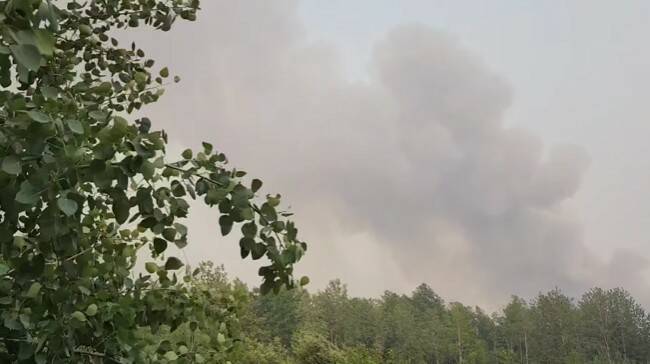
ARLENE MCKAY / FACEBOOK
Wildfire smoke as seen from Garden Hill Anisininew Nation.
Mayor Ron Scott said a new fire, about 16 km southwest of Snow Lake, prompted the latest evacuation.
“This is totally unprecedented,” he said about a second evacuation in a single wildfire season. “I think everybody is feeling a little bit frustrated and stressed out. We hoped it wouldn’t happen again.”
The evacuation was ordered after the Manitoba Wildfire Service informed the town high winds were expected to push the 3,000-hectare blaze closer to Snow Lake.
Most evacuees drove out on their own and a majority is expected to stay with friends and family. Scott said one resident left via a medical evacuation flight.
Those who don’t have personal transportation boarded two buses bound for a reception centre and congregate shelter at an indoor soccer complex on Leila Avenue in Winnipeg.
The City of Winnipeg also offered Billy Mosienko Arena in case space is needed, Kinew said. “The reality is that people who evacuate in Manitoba now will be heading to congregate shelters for the most part.”
Some hotel rooms are set aside for elders or people with “high medical needs,” the premier added.
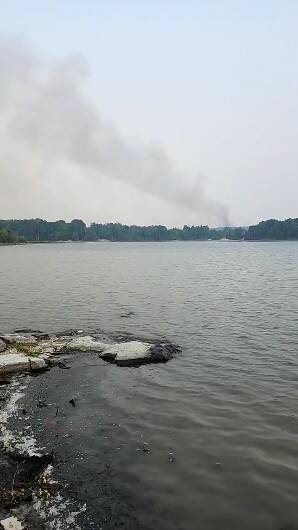
ARLENE MCKAY / FACEBOOK
The Armed Forces began airlifting evacuees out of Garden Hill Anisininew Nation on Wednesday night.
Tataskweyak Cree Nation (Split Lake) said it is sending more of its evacuees to Niagara Falls, Ont., where about 1,400 people from northern Manitoba were staying as of last week.
McDougall said Niagara Falls was mentioned as a possible destination for Garden Hill evacuees, too.
The premier said Alberta has also offered to take in evacuees from Manitoba.
Thompson is pre-registering residents in case an evacuation of all or parts of northern Manitoba’s largest city is necessary. The province has been preparing in case it needs to find hotels or shelter space for some or all of its 13,000-plus residents.
An out-of-control blaze north of Thompson was an estimated 10,000 hectares. Hayward said rain helped crews make good progress Thursday to help shore up the fire’s southern side, which is threatening the city.
Meantime, organizers of two upcoming events at the Winnipeg convention centre were not advised of any changes to their plans while part of the building is used as an evacuation site.
Mario Tenuta, executive chair of the organizing committee for the Soils for Our Future conference, said the event will go ahead as scheduled July 20-25, after speaking to convention centre officials.
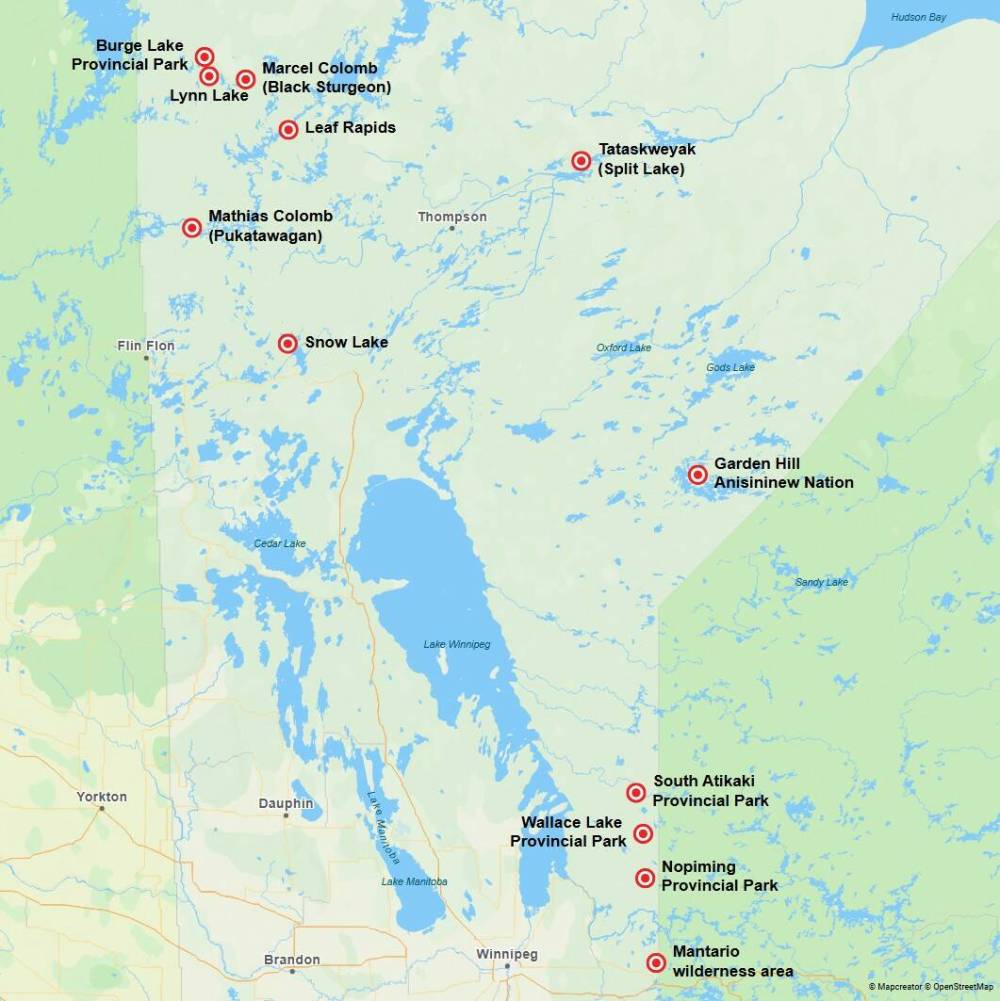
Map shows mandatory evacuation zones. Voluntary or medical evacuations are taking place in at least three communities: Nisichawayasihk Cree Nation (Nelson House), O-Pipon-Na-Piwin Cree Nation (South Indian Lake) and Pimicikamak Cree Nation (Cross Lake).
He was told the third-floor exhibition hall, which is the venue’s largest space, will be prepared for evacuees. Tenuta said the Soils for Our Future conference is being held in rooms on lower floors.
“Everybody is nervous about Thompson. If Thompson is evacuated, that will be a big issue for the whole province,” he said.
The convention centre will host some Folklorama pavilions in August. Folklorama spokeswoman Vanessa Desorcy said the organization has not received any information that would indicate the pavilions would be affected.
chris.kitching@freepress.mb.ca
Current evacuations
Mandatory evacuation orders were in place for the following communities or areas as of Thursday:
• Atikaki Provincial Wilderness Park
• Burge Lake Provincial Park
• Garden Hill Anisininew Nation
• Leaf Rapids
• Lynn Lake
• Mantario wilderness area in Whiteshell Provincial Park
• Marcel Colomb First Nation (Black Sturgeon Falls)
• Mathias Colomb Cree Nation (Pukatawagan)
• Nopiming Provincial Park: Most of the park is closed, except the northwest corner, including Quesnel Lake, and the southern areas of Bird, Booster, Flanders and Davidson lakes (for permanent residents, cottagers and commercial operators).
• Snow Lake
• South Atikaki Provincial Park
• Tataskweyak Cree Nation (Split Lake)
• Wallace Lake Provincial Park
• Wekusko Falls Provincial Park
Voluntary or medical evacuations are taking place in at least three communities, which are not under mandatory evacuation orders:
• Nisichawayasihk Cree Nation (Nelson House)
• O-Pipon-Na-Piwin Cree Nation (South Indian Lake)
• Pimicikamak Cree Nation (Cross Lake)
Hot spots
The Manitoba Wildfire Service continues to respond to 105 active wildfires. Fires of note include:
Northern region:
• Fire NO002, located near the town of Lynn Lake, is approximately 80,120 ha and is out of control.
• Fire NO042, located 14 km southwest from the town of Lynn Lake, is approximately 9,525 ha and is out of control. A mandatory evacuation order is in place for the town of Lynn Lake and Marcel Columb First Nation.
• Fire NO005 (combined with Fire NO055), located near Pimicikamak Cree Nation (Cross Lake), the Incorporated Community of Cross Lake, Jenpeg Generating Station and Whiskey Jack Landing, is approximately 84,375 ha and is out of control.
• Fire NO010, located near Tataskweyak Cree Nation (Split Lake), is approximately 22,275 ha and is out of control. A mandatory evacuation order remains in place for Tataskweyak Cree Nation (Split Lake).
• Fire NO026, located 14 km from the town of Leaf Rapids, is approximately 6,820 ha and is out of control. A mandatory evacuation order is in place for the town of Leaf Rapids.
• Fire NO047, located 26 km from the town of Leaf Rapids, is approximately 7,015 ha and is out of control. A mandatory evacuation remains in place for the town of Leaf Rapids. Wildfire smoke may impact PR 391.
• Fire NO061, located 14 km from the city of Thompson, is approximately 12,500 ha and is out of control.
• Fire NO076, located seven km from Wabowden, is approximately 44 ha and is out of control.
• Fire NO079 (combined with Fire NO082), located near Garden Hill First Nation (Kistiganwacheeng), is approximately 2,500 ha and is out of control. A mandatory evacuation order is in effect for Garden Hill First Nation effective July 10.
Eastern region:
• Fire EA061 remains out of control at approximately 234,390 ha. A closure and mandatory evacuation order continues for parts of Nopiming Provincial Park and the entire areas of Wallace Lake and South Atikaki provincial parks. PR 314 remains closed through Nopiming Provincial Park, as well as PR 304 east of Bissett. The southern portion of Atikaki Provincial Park is also closed, including the Bloodvein and Gammon river corridors and Aikens Lake.
Western region:
• Fire WE017, located near Sherridon and the city of Flin Flon, is approximately 370,780 ha and is out of control. For the safety of personnel, boaters are asked to avoid waterways being utilized by Manitoba Wildfire Service tankers and aircraft.
• Fire WE025, located near Mathias Colomb Cree Nation (Pukatawagan), is approximately 59,220 ha and is being monitored. The fire is contained around the community but a mandatory evacuation order continues.
• Fire WE028, located 10 kilometres (km) from Bakers Narrows Provincial Park, is approximately 7,200 ha and is out of control.
• Fire WE052, located 20 km from Snow Lake, is approximately 3,000 ha and is out of control. A mandatory evacuation order was issued for the town of Snow Lake effective noon today.
• Fire WE053, located 16 km from Snow Lake, is approximately 4,370 ha and is out of control.
• Fire WE059, located 12 km from Snow Lake, is approximately four ha and is under control.

Chris Kitching is a general assignment reporter at the Free Press. He began his newspaper career in 2001, with stops in Winnipeg, Toronto and London, England, along the way. After returning to Winnipeg, he joined the Free Press in 2021, and now covers a little bit of everything for the newspaper. Read more about Chris.
Every piece of reporting Chris produces is reviewed by an editing team before it is posted online or published in print — part of the Free Press‘s tradition, since 1872, of producing reliable independent journalism. Read more about Free Press’s history and mandate, and learn how our newsroom operates.
Our newsroom depends on a growing audience of readers to power our journalism. If you are not a paid reader, please consider becoming a subscriber.
Our newsroom depends on its audience of readers to power our journalism. Thank you for your support.
History
Updated on Thursday, July 10, 2025 1:09 PM CDT: Adds details, photos.
Updated on Thursday, July 10, 2025 1:09 PM CDT: Adds box
Updated on Thursday, July 10, 2025 4:33 PM CDT: Adds map
Updated on Thursday, July 10, 2025 5:22 PM CDT: Adds details
Updated on Thursday, July 10, 2025 6:07 PM CDT: Adds details, comments.
Updated on Thursday, July 10, 2025 8:53 PM CDT: Adds photo










